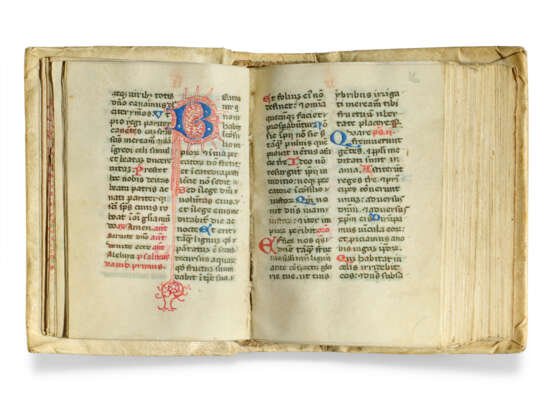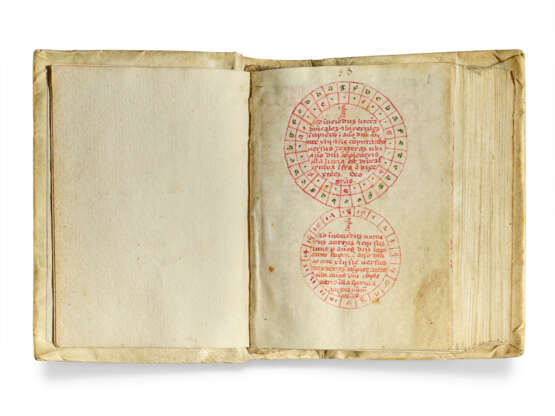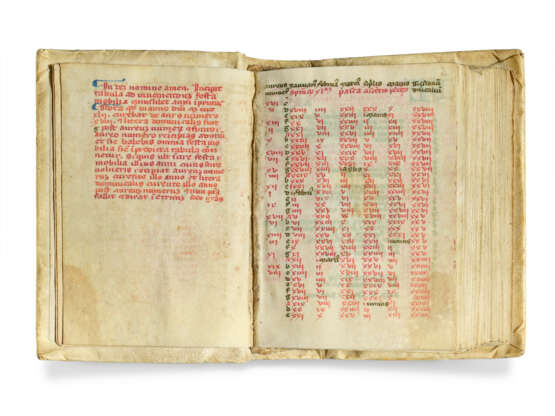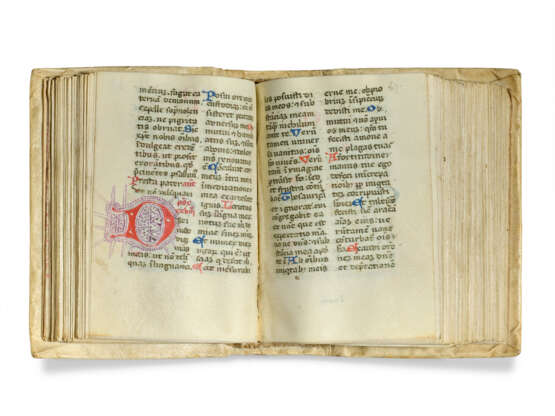ID 1450523
Lot 11 | A Celestine Psalter
Estimate value
£ 4 000 – 6 000
Psalter, for Celestine use, in Latin, decorated manuscript on vellum [Central Italy], 1442
A charming, complete and diminutive Italian Psalter conceived for use by a Celestine house in 15th-century Italy.
82 x 60mm. ii (paper) + 265 + iii (paper) leaves, complete, collation: 18, 2-2710, modern foliation in pencil, catchwords survive, 20 lines in two columns, ruled space: 55 x 17mm, rubrics in red, initials alternately in red or blue throughout, larger initials at the major divisions of the Psalms in blue with red penwork flourishing or red with purple penwork flourishing, two circular diagrams in red for the dominical letters and golden numbers, one table with corresponding instructions to calculate moveable feasts and Easter (gatherings 25-27 misbound – ff.236-265v should come after f.215v – but with no loss of text, a few wormholes to final gatherings and one or two margins, a few stains to opening leaves, else in excellent condition). Bound in 17th-century limp vellum over pasteboards.
Provenance:
(1) The feast of Pope Celestine V on 19 May in red, his translation on the 15 February, and the preponderance of Benedictine and Franciscan saints (Benedict on 21 March ‘abbatis nostris’, St Francis on 4 October ‘Sancti Francisci nostris’, Scholastica on 10 February, Maurus on 15 January and Anthony Abbot on 17 January, both the proprietary epithet ‘nostris’) in the calendar suggest that this diminutive Psalter may have been produced for use in a Celestine house in central Italy (there are a number of feasts in the calendar for dedications to Roman churches). Celestine, or Pietro da Morrone, founded the order of the Celestines as a branch of the Benedictine order in 1244. While fundamentally Benedictine, the order also had ties to radical Franciscans. The year 1442 is mentioned in the tables for the domical letters, as well as in the instructions facing the table for moveable feasts and Easter.
(2) By family repute in the collection of John Ruskin (1819-1900), English polymath, art historian and philanthropist. In the same English collection since the 1930s.
Content: Tables for calculating the 'golden numbers' and 'dominical letters', which aided determining on which weekday a date would fall in a given year, moveable feasts and how to calculate Easter ff.1-2; Calendar ff.2v-8; Prologue of St Jerome on the first book of the Psalter ff.9-14v; hymns ff.14v-15v; Psalter, including Jerome’s prologues for books II, III, IV and V at ff.70, 105v, 134v and 159v, with ferial canticles and Athanasian Creed ff.15v-215v and ff.236-253; Seven Penitential Psalms, litany and prayers ff.253-258; Hymnal, arranged according to the liturgical year with the Temporale, the Sanctorale, and the Common of Saints, ff.258-265v and ff.216-235v.
| Place of origin: | Italy, Europe |
|---|---|
| Auction house category: | Medieval & renaissance manuscripts, Books and manuscripts |
| Place of origin: | Italy, Europe |
|---|---|
| Auction house category: | Medieval & renaissance manuscripts, Books and manuscripts |
| Address of auction |
CHRISTIE'S 8 King Street, St. James's SW1Y 6QT London United Kingdom | |
|---|---|---|
| Preview |
| |
| Phone | +44 (0)20 7839 9060 | |
| Buyer Premium | see on Website | |
| Conditions of purchase | Conditions of purchase |






